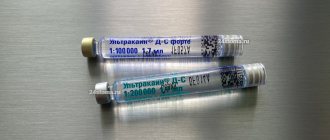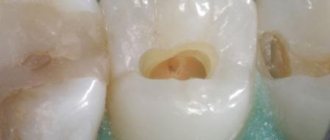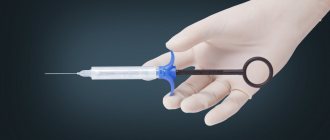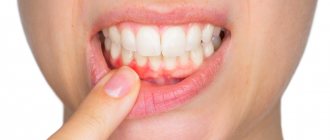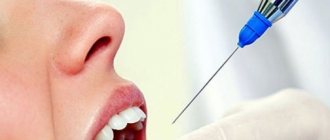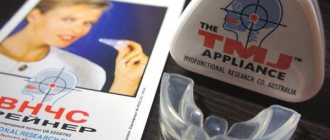We are publishing an article by Natalya Lvovna Mayorova, a dentist, therapist, and head of the therapeutic department of the Dentalika clinic.
Pain relievers used in modern dental practice can work wonders. After receiving an anesthetic injection, the patient does not feel any pain or even particularly unpleasant sensations. To ensure that the injection itself is painless, before the procedure the doctor “freezes” the injection site with a special preparation with a delicious smell of cherry, lemon, or apple.
Local anesthesia is the main method of pain relief used in dental practice. With local anesthesia, the patient remains fully conscious, and this allows the doctor to fully control the entire course of treatment, communicate with the patient, and monitor your reaction.
The quality of dental interventions depends on the results the doctor obtained during local anesthesia. Therefore, achieving 100% pain relief is necessary not only for the patient, but also for the doctor, in order to carry out treatment calmly, slowly, and efficiently. Hence the following requirements for local anesthetics:
- they must have a strong analgesic effect, easily penetrate into tissues and remain there for as long as possible;
- have low toxicity, causing a minimum number of both general and local complications
Based on these wishes, we chose several widely used drugs:
- Ultracaine DS forte (4% articaine, adrenaline 1:100,000);
- Ultracaine DS (4% articaine, adrenaline 1:200,000);
- Scandonest SVC (3% mepivacaine; without vasoconstrictors - adrenaline).
Now in more detail about their action.
Description of the drug
Scandonest without adrenaline is produced in blisters of 10 ampoules each. The drug is intended for professional use and is administered by injection into soft tissue.
Compound:
- mepivacaine hydrochloride;
- sodium hydroxide;
- sodium chloride;
- saline solution
The active ingredient of Scandonest is mepivacaine hydrochloride, the action of which is aimed at blocking the nerve impulses responsible for pain. Unlike other painkillers, Scandonest is characterized by a vasoconstrictor effect. This is radically opposite to the effect of medications that dilate the lumen of blood vessels.
Note! Scandonest is used for pain relief in patients for whom adrenaline is contraindicated.
The anesthetic effect lasts at least 30 minutes and occurs 3-4 minutes after administration of the drug. After 1.5 hours, the drug is partially eliminated from the body. However, it should be borne in mind that no more than 10% of the drug is excreted by the kidneys; the liver takes the brunt. Therefore, any pathological changes in the liver can lead to problems.
Note! When using local anesthetics, the patient remains conscious and responds adequately to the situation.
The result of using Scandonest is loss of sensitivity to pain. There is not even any unpleasant sensation. Before administering the medicine, the dentist freezes the area so that there is no discomfort during the injection. After the drug begins to act, therapy takes place in a calm environment.
Pharmacokinetics
Injected into the oral cavity through local infiltration anesthesia, mepivacaine reaches its peak concentration in the blood approximately 30 minutes after the injection. The half-life is long and is approximately 90 minutes.
Mepivacaine is metabolized quite quickly and only 5-10% is excreted unchanged in the urine. Having an amide structure, mepivacaine is not metabolized by plasma esterases. The liver is the main site of its metabolism. Any liver pathology (cirrhosis, hepatitis) leads to a general accumulation of mepivacaine.
Application in pediatric dentistry
Scandonest is used in pediatric dentistry, as it provides 100% pain relief and does not cause negative side effects. This is especially true for young patients under five years of age for whom adrenaline is contraindicated. After the age of five, children can be treated for pain with drugs containing adrenaline, for example, Ultracain DS. The dosage of the medicine corresponds to the age of the small patient.
The dentist’s work with the child should be carried out with the child’s complete trust in the doctor. After pain relief, the child gains confidence in the dentist and allows the necessary therapy to be carried out.
How does Scandonest interact with other medications?
To avoid an additive effect, the anesthetic should not be used in combination with a number of other medications. This category of drugs includes sedatives and antihistamines, as well as antiarrhythmic drugs that help reduce the frequency of contractions and myocardial conductivity.
The anesthetic should not be combined with certain drugs
Indications and contraindications
Scandonest is widely used in dentistry for the treatment and extraction of teeth, surgical manipulations on the oral mucosa, and during operations on the jaw.
Absolute contraindications:
- intolerance to the ingredients of the drug;
- severe diseases of internal systems;
- pathology of hemoglobin formation (porphyria);
- muscle weakness (myasthenia gravis);
- children under five years of age.
Relative contraindications:
- pregnancy and breastfeeding;
- renal/liver failure;
- cardiovascular pathology;
- elderly patients over 65 years of age;
- inflammatory processes at the injection site.
The dosage of the medication depends on the age of the patient and the nature of the treatment procedures. For patients over 65 years of age, the dose of administration is half the usual dose.
Scandonest during pregnancy is prescribed with great caution after the approval of the gynecologist. The active substance is easily absorbed by the placenta and penetrates into the fetus. When feeding, you need to take into account the time it takes for the substance to be removed from the body. The active ingredients can pass into breast milk, but in small quantities.
Side effects
Any medicinal substance can cause negative effects of varying severity. In the case of using Scandonest, these may be reactions of different body systems.
CNS:
- drowsiness and lethargy;
- motor impairment;
- failure of tactile sensations;
- dizziness, headache;
- excessive excitability, anxiety;
- trembling of limbs;
- dilated pupils;
- loss of consciousness.
Vascular system:
- arrhythmia, tachycardia;
- decrease in pressure;
- bradycardia;
- pain in the sternum.
The patient may experience nausea and vomiting, fecal and urinary incontinence, and respiratory depression. In some cases, allergy symptoms may occur - hives, itching, rashes, swelling at the injection site. Numbness and a cold feeling at the injection site (as well as the lips and tongue) are common symptoms. Severe side effects include the patient's state of shock.
Important! The appearance of side effects requires qualified medical care.
Scandonest slows down motor reactions, so after use it is not recommended to drive a vehicle or work with equipment that requires concentration and precise movements.
Precautions
To avoid allergic reactions, it is recommended to do a test test by injecting a small volume of the drug - 5%.
Patients should not eat or chew gum until tissue sensation is fully restored. There is a certain risk of biting your lip, cheek or tongue.
Analogs
Analogues of the drug Scandonest contain one or more substances with identical effects. The following substitutes are used in medical practice:
- Isocaine;
- Mepivacaine;
- Mepivastezin;
- Mepidont;
- Mepicaton;
- Scandinips;
- Ultracaine DS;
- Articaine.
Isocaine
Isocaine, produced in Canada, is a local anesthetic medicine for blocking pain. The active ingredient is mepivacaine. The medicine is produced in injection ampoules intended for professional use. For local anesthesia, a 3% solution of the drug is administered, the dosage depends on the nature of the intervention.
Mepivacaine
Mepivacaine is a synonym for Scandonest, fully consistent with its composition and action. The drug is less toxic than lidocaine and also less effective. Mepivacaine is not recommended for use in patients with poor blood clotting. During soft tissue surgery, severe blood loss is possible, which can only be stopped by vasoconstrictor adrenaline. In some cases, patients are prescribed blood thinners several days before receiving Mepivacaine.
Mepivastezin
Mepivastezin is a drug for submucosal injection used in dentistry and for surgical interventions. The drug has local anesthetic and immunomodulatory effects. The active substance is mepivacaine. Mepivastezin is not recommended for use in patients with poor health or with severe kidney/liver pathologies. The drug is not recommended for use in early pregnancy due to its toxic effect on the fetus; breastfeeding can be continued one day after administration of the drug dose.
Mepidont
Mepidont is produced in Italy. This is a complex drug that contains mepivacaine and epinephrine. Epinephrine has a constricting effect on blood vessels and enhances the properties of mepivacaine. The drug is intended for professional use; prior consultation with a doctor is required before administration. Side effects are similar to other drugs based on mepivacaine, and allergic reactions are possible. Mepidont does not combine well with some medications, so on the eve of treatment the use of medications should be discontinued.
Scandinibsa
Scandinibsa, produced in Spain, based on mepivacaine, has local anesthetic properties and is administered by injection into soft tissue. Mepivacaine enhances the healing properties of other drugs that block the sensitivity of the central nervous system. Side effects occur due to sensitivity to the substances that make up the drug. In case of severe side effects syndrome, medical assistance should be provided. Eating is allowed only after the sensitivity of the nerve endings has been restored.
Ultracaine
Ultracaine is often used for treatment in the dental office. This drug does not cause significant side effects or contraindications. With the help of Ultracaine, a wide variety of dental procedures are performed, the patient does not feel pain. The drug is also used in pediatric dentistry, but after the age of four.
Important! Ultracaine is approved for use by pregnant women, but with the permission of a gynecologist.
The drug contains adrenaline, but in very small quantities. Ultracaine can be used to relieve pain in patients with high blood pressure and cardiovascular pathologies. In case of severe pain, the dosage of the drug may be increased.
Dentists give advantages to Ultracaine, which is several times greater than the effect of Lidocaine. The analgesic effect lasts a minimum of 20 minutes and can last up to 40 minutes. Ultracaine forte anesthetizes tissue within 1 hour 15 minutes.
Bottom line
Tooth extraction, removal of pulpitis and operations on soft tissues of the oral cavity should be carried out under local anesthesia. Scandonest in dentistry is a new generation anesthetic based on mepivacaine, which does not contain adrenaline. It can be administered to patients sensitive to the effects of adrenaline and who have contraindications to the use of lidocaine. This drug is also used in gynecology and in the treatment of other diseases.
Sources used:
- Solovyova A. A. (2015) Fundamentals of anesthesiology. Local and general anesthesia
- Manufacturer website Septodont (France)
- Anesthesiology and resuscitation, ed. Dolina O. A., M. GEOTAR-Media, 2006
- Bernardsky Yu. I. Fundamentals of maxillofacial surgery and surgical dentistry. - M.: Medical literature, 2000.
Failed anesthesia
I would also like to touch upon the topic of unsuccessful local anesthesia. Almost every dentist has encountered this in their practice. The reasons for this phenomenon can be classified into 2 groups:
- depending on the doctor (poor choice of anesthesia technique and anesthetic solution; errors in the technique);
- depending on the anatomical and psychological characteristics of the patient.
To eliminate psychological causes in patients with a labile psyche (with increased emotionality, sensitivity, excitability), premedication is used: sedatives and sedatives.
In all other cases, the doctor must approach the choice of anesthetic and local anesthesia technique with even greater responsibility and professionalism, starting from the very first minutes of communication with the patient (history collection).
You should always remember that there are NO teeth that cannot be anesthetized, it’s just sometimes more difficult to achieve this.
High-quality pain relief minimizes patient discomfort and allows dentists to perform the necessary interventions.
Natalya Lvovna Mayorova doctor - therapist - dentist October 2009
Dear Colleagues! When copying information, placing a link to the source site is mandatory.

